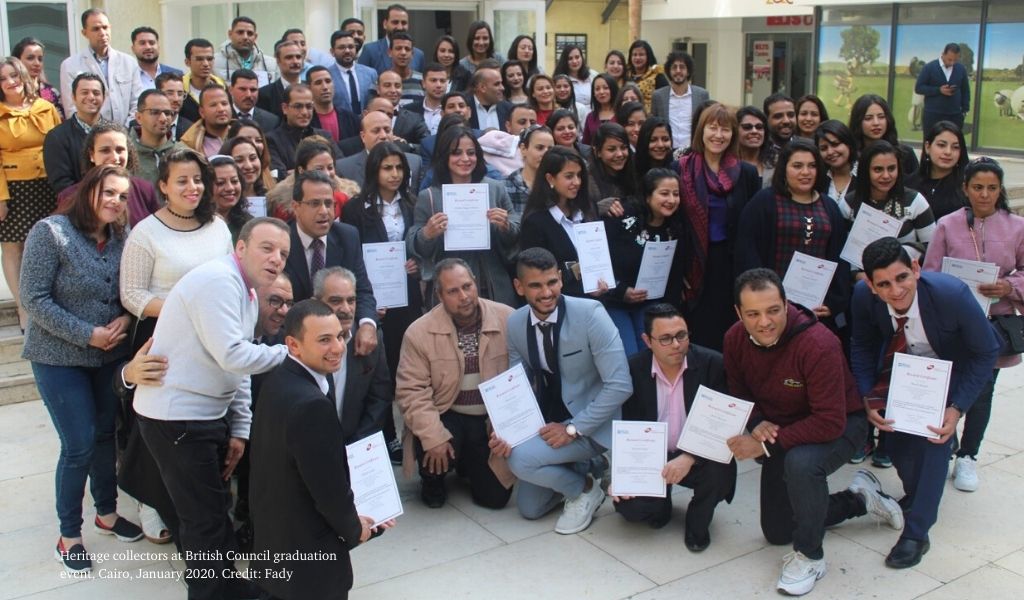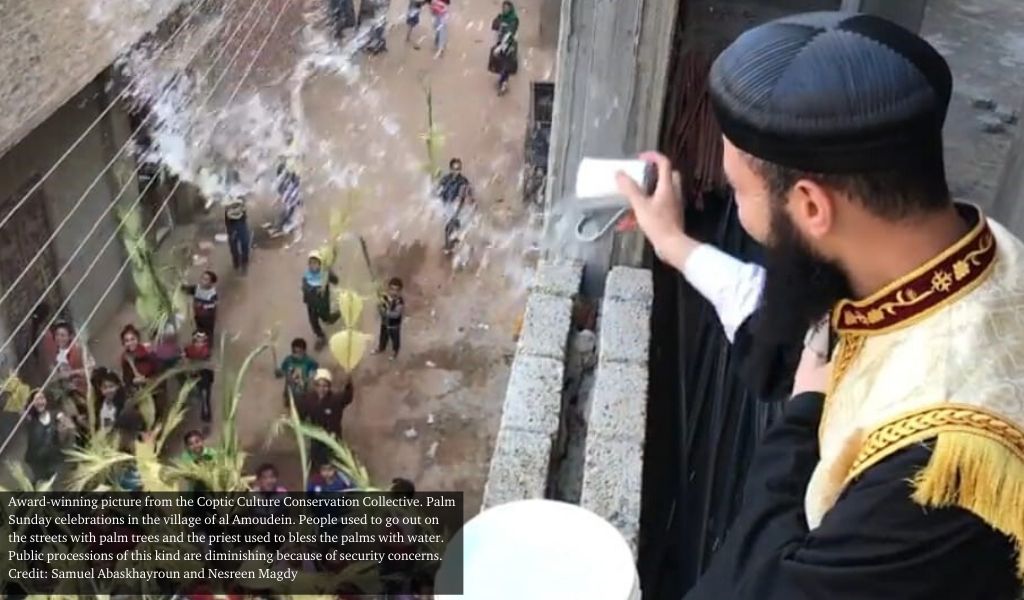Last week, 86 young Egyptian Copts from Upper Egypt celebrated their past and future as “heritage collectors”. Karen Fanous was there to capture the buzz.

On the 15 of January 2020, 86 heritage collectors from 34 different communities in Upper Egypt, together with their team coordinators, gathered in the British Council in Egypt in a celebration of their graduation from a capacity building programme which helped them to identify, understand, collect, synthesise, analyse and share people’s heritage.
“Our aim was to look for those whose voices are not heard – the women, Copts, youth. Heritage of those on the margins was our priority” explained Professor Mariz Tadros, research fellow at the Institute of Development Studies, who led the Coptic Culture Conservation Collective project and opened the event.
The room was bustling, filled with the laughs, and proud smiles of the graduates who were extremely well-dressed, not just physically but also with pride and achievement. Their sense of ownership of the material they had collected and responsibility towards the preservation of their own heritage as well as the creation of a new more positive heritage, was palpable.
“We dug in dust and found gold”
Ms. Cathy Costain, Head of Arts at the British Council in Egypt, welcomed all those who gathered and emphasised the importance of heritage preservation to the British Council:
“Heritage isn’t just about buildings or artefacts, it is about how people live, and the culture of our daily lives.”
Her speech was followed by a panel discussion during which the four team coordinators, who had each managed a team of 22-22 heritage collectors, spoke of how they perceived the programme, the efforts of their teams, and how the programme expanded significantly. Indeed, in one year, the number of thematic categories in which stories were collected multiplied from 9 categories to 23, based on the insights by the collectors themselves.
“I know we call them heritage collectors, but I’d like to call them heritage prospectors,” said Mr. Michael Kamal from the Coptic Catholic Diocese of Minya. “They are not collecting something that was there and visible, but they dug a lot to find it; they exerted a lot of effort in this.”
The programme found a great appeal in the communities themselves, who considered it an opportunity to express and preserve their own stories.
“People were approaching us to tell us their stories, we dug in dust, and found gold”, explained Mr. Michael.
One important result of the programme was how both team coordinators, and their team members increased their set of tangible and intangible skills, evolved in their thinking of what heritage entailed, and developed on the cognitive, personal, and interpersonal levels.
“We started seeing things differently, we started noticing the people, we better understood people’s incentives and behaviors” said Mr Mina Magdy, from the Coptic Association for Social Care.
Documenting traditions and acts of courage in the community
Ms. Elizabeth White, the Director of the British Council in Egypt, welcomed and congratulated the collectors on finishing the programme. In a spirit of true pride and celebration, Ms. White distributed certificates to all the heritage collectors which included a personalised and encouraging message for each one of them.
In the afternoon, awards were given to the three best digital stories, chosen from each team. Each winner spoke about why they chose their stories from the narratives they had collected to be recorded. The rewarded digital stories included one that highlighted traditions related to certain religious festivals, birth, weddings, or deaths.

They also included one that shone a light on acts of bravery by church leaders, or, gave examples of families who decided to stand-up against negative practices in their communities, and the role of the Coptic community in the economic and social development of their communities.
“A ray of hope”
In one story, a church leader saved his church from attacks by Islamist militants who had wanted to burn it in the aftermath of the dispersion of a Raba’a Muslim Brotherhood sit-in, using just a water hose. For Nagwa Mohsen, the story collector, “the story was to the community a ray of hope.”
Another story featured three underprivileged brothers who insisted on dividing their inheritance equally with their sister, despite being obliged by Law to only pay her half of their share. Magdy, the story collector said “these men have very little income and are uneducated, but still, they insisted on applying the Biblical command of justice. A lot of people in the village now are following their path and model.”
Awards were also given for photos from each team . Each photo was unique and provided different examples of the themes of the project. Two men and two women were chosen, and the winning photos were gifted to the British council, and the British ambassador later in the day.
Other outputs of the project were also portrayed and celebrated as collective and joint efforts by multiple collectors including two professional videos that covered the important aspects of religious festivities in the communities, and two books, one on the story of the Deir el Barsha community, and the other documenting heritage in Minya in the post-2011 period.
Mr Ayman Erian, the author of the latter said: “History is focused on the church leaders, priests, pastors, and clergy, but now we want to document the stories and struggles of the Coptic people themselves.”
Reception at the British Ambassador’s residence
The graduation celebration at the British Council was followed by a reception at the British Ambassador’s residence, who celebrated the efforts of the team and hosted the research team, team coordinators, and project partners.

His Excellency, Sir Geoffrey Adams then highlighted the importance of the project and its origins in the Cultural Protection Fund:
“The background is that some years ago, the British government, in cooperation with the British Council, decided to allocate a sum of money for the protection and preservation of cultural heritage, because it was clear to us in Britain that there are too many countries in the world where cultural heritage was under threat. Under threat in some cases from conflict, in other cases simple neglect. We felt those cultural heritage is universal…..it belongs to everyone. We felt that we as Britain we should do our bit to preserve and protect that heritage, hence the Cultural Protection Fund.”
Professor Tadros then introduced the objective of the project and how it embodied the nexus between cultural heritage and development, and how it developed over time due to the input by the collectors and the community:
“Our main slogan is ‘from the community, in the community, to the community’, we wanted youth from the communities to collect heritage and tell us what is fading, what faded, and what new heritage they are creating.”
The project has resulted in hundreds of oral histories, dozens of digital stories, hundreds of pictures, several professional videos, several books and material which will be shared online and through a television series. The whole day was documented by Al Horreya TV channel, which agreed to also air 23 different episodes, one on each thematic category produced by the project.
This blog was written by Karen Fanous. Ms. Fanous is an Egyptian development consultant specialising in areas of women’s empowerment and Coptic community strengthening, and currently doing her Master’s in Poverty and Development at IDS.